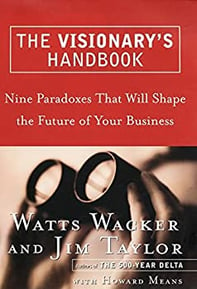
Many years ago I read Watts Wacker’s and Jim Taylor’s “The Visionary’s Handbook”. Among the benefits of Covid is a revisiting of the book’s lining the various shelves in my workspace. The concepts explored in the book written near twenty years ago is, if possible, even more relevant today.
There are “Nine Paradoxes That Will Shape The Future of Your Business”.
Each paradox stands on its own, but in combination are powerful reminders about the questions and the answers that will shape our times. My preference in writing has been to ask questions that provoke rather than provide answers. This book is all about questions stimulated by the paradoxes, and more than satisfies my preference.
As an aside “Watts Wacker” was his real name. When I first read the book and met him I was convinced his name was a “nom de plume”. Not so, it is his real name. If I ever write a book it will be, hopefully, with a name like Watts Wacker”.
And he was truly a futurist. His writing, thinking brought to mind Buckminster Fuller. Wacker passed several years ago, but much of his work is alive and well online in videos and writings. Among his written works in collaboration with others are “The Deviant’s Advantage”, (how to use fringe ideas to create mass markets) and “The Five Hundred Year Delta”, (what Happens After What Comes Next).
Although, there are “Nine Paradoxes” explored in the book, it is “Paradox I” that I’ll explore in depth in my next post.
For now, though a summary of the “Nine” just for a taste.
“I…. THE PARADOX OF THE VISIONARY”
“The more you are right, the more wrong you will be.” Or…….
“The closer your vision gets to a provable truth, the more likely you are to simply be describing the present. In the same way, the more certain you are of any future outcome, the more likely you’ll be wrong.”
“II…THE PARADOX OF VALUE”
“The value of any product is inseparable from the buyer’s perception of worth. Instead of intrinsic value, everything has relative value only.”
“III…. THE PARADOX OF SIZE”
“The bigger you are, the smaller you have to be. And the smaller you are in reality, the bigger you need to appear to be.”
“IV……THE PARADOX OF TIME”
“To succeed in the short term you need to think long term. Yet the greater your vision and the greater your timeframe, the greater the risk that you will be unable to take the necessary short-term steps to achieve long-term goals. The tension between short term and long term has never been greater.”
“V…….THE PARADOX OF COMPETITION”
“Your biggest competitor is always your own view of the future. Competition comes from everywhere and nowhere at the same time”
“VI……THE PARADOX OF ACTION”
“Nothing turns out quite the way you expect it to. Therefore, act intuitively but be ready to act counterintuitively if required.”
“VII…… THE PARADOX OF LEADERSHIP”
“To lead from the front, you need to stay inside the story. In an inherently inconsistent world, consistency is not the virtue it once was… especially in leaders.”
“VIII….. THE PARADOX OF LEISURE”
“Play is hard work, in fact, play and work are blending together so as to be virtually indistinguishable.”
“IX….. THE PARADOX OF REALITY”
“….. in essence, says there is no such thing as reality — -just a pool of everyone’s individual interpretation of reality. Therefore, since everyone is going to interpret everything around them by the light of their unique experience, an activity like marketing cannot effectively be carried out to the masses — -it has to focus on a niche of one.”
In the coming posts, I’ll write a bit more about these Nine Paradoxes, what’s changed since their origin 20 years ago, what hasn’t changed and what might be their relevance today.
Stay tuned… and any questions?
Leaders search for opportunities to change the status quo. They look for innovative ways to improve the organization. In doing so, they experiment and take risks. And because leaders know that risk taking involves mistakes and failures they accept the inevitable disappointments as learning opportunities.
Because these learning opportunities are often the best time for leaders to reach outside their organization for help, Beyond Teal presents: Executive Leadership Guidance


